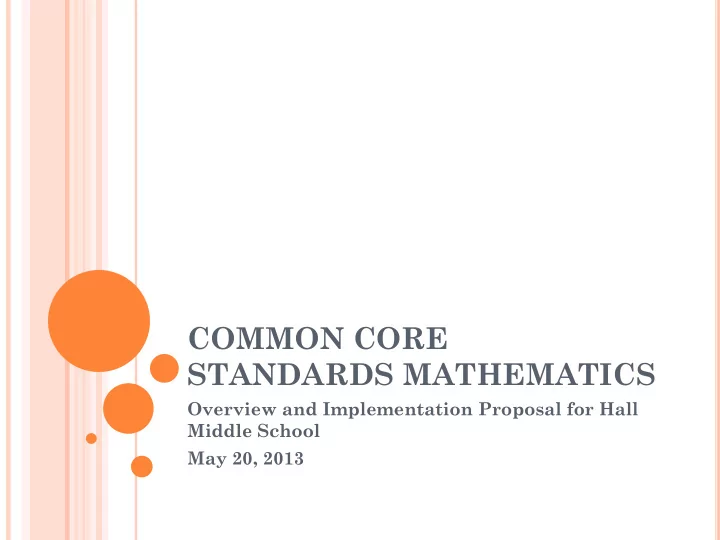

COMMON CORE STANDARDS MATHEMATICS Overview and Implementation Proposal for Hall Middle School May 20, 2013
O UR C OMMITMENT : To provide a math curriculum that challenges all students. To implement the Common Core standards with fidelity. To ensure that all students are provided with a solid math background that fully prepares them for success in high school and beyond. To collaborate with our partner middle and high schools for consistent preparation for all students and opportunities for teacher professional development.
COMMON CORE STATE STANDARDS MATHEMATICS DEVELOPMENT CORE DEVELOPMENT Common Core State Standards were developed in an effort to bring US standards in line with high performing international countries. Written by 3 math educators as opposed to a committee of bureaucrats, like most previous state standards. Most states have adopted them in order to qualify for Race to the Top funds .
CHARACTERISTICS OF COMMON CORE MATH Fewer and more rigorous topics Aligned with college and career expectations Internationally benchmarked Rigorous content and application of higher- order skills Builds on strengths and lessons of current state standards Research based Intent is to be coherent, focused, clear and specific
OVERVIEW OF COMMON CORE MATH Greater opportunities for differentiation Focus on mathematical thinking rather than a discrete set of skills that result in simply correct or incorrect answers. Students can access this mathematical thinking at many different levels. Standards of Mathematical Practices are the same K-12.
M ATHEMATICAL P RACTICES Make sense of problems and persevere in solving 1. them. Reason abstractly and quantitatively. 2. Construct viable arguments and critique the 3. reasoning of others. Model with mathematics. 4. Use appropriate tools strategically. 5. Attend to precision. 6. Look for and make use of structure. 7. Look for and express regularity in repeated 8. reasoning.
C URRENT VS . SBAC T ESTING Current STAR Assessments Proposed SBAC Assessments • Grades 3-8 and 11, Grades 9 Grades 2-11, writing at and 10 available for states 4 th and 7 th that choose to use them • Delivered via computer and Only paper & pencil are computer adaptive option • 60% will be assessed using Only multiple choice performance assessment and scored using an analytic Part of the state and point scoring rubric federal accountability (fashioned after MARS rubrics) system • 40% selected response will be machined scored
THE 8 TH GRADE PENDULUM SWING WHERE WE ’ VE WHERE WE ’ RE BEEN: GOING: • Increase number of • CC Math 8 and Algebra students taking 1 courses are more Algebra in 8 th grade rigorous and deep course than previous • Select students take Algebra course Geometry in 8 th grade • Developmentally designed for high school • Goal - to take students who have had Calculus in 12 th a strong foundation in grade middle school math • Reality - not all • Carefully select students are students taking Algebra successful in 8 th grade
Pathways for Common Core Math K-12 9 th grade: 10 th grade: 11 th grade 12 th grade K-6 7th grade 8th grade CCSSM 7 th CCSSM 8 th CCSSM CC SSM CCSSM PreCalculus grade math grade math Algebra 1 Geometry Algebra 2 / AP Statistics (Math 7) (Math 8) /Business Math CCSSM 7 th CCSSM CCSSM CCSSM CCSSM PreCalculus/ AP Calculus/ grade math Algebra 1 Geometry Algebra 2 AP Statistics AP Statistics (Math 7) • These pathways are fluid. It is possible that students could move to a different pathway during or at the end of the school year. • Pathways in 11 th and 12 th grade may vary
N O G EOMETRY IN M IDDLE S CHOOL ? The CCSSM are more rigorous & comprehensive than previous standards. “ Skipping over material to get students to a particular point in the curriculum will create gaps in the students ’ mathematical background. ” “ Acceleration will require compaction and not the former strategy of deletion. ” “ In order to accelerate, students must prove that they are proficient in the CCSSM for grades K-8. ” (California Draft Mathematics Framework, April, 2013)
P REPARATION FOR H IGH S CHOOL M ATH “ The standards from Grade 7, Grade 8, and the Algebra I (or Mathematics I) course could be compressed into an accelerated pathway for students in grades 7 and 8, allowing students to enter the Geometry (or Mathematics II) course in grade 9. ” (California Draft Mathematics Framework (April, 2013) “ Skimming over existing materials in order to rush ahead to more advanced topics will no longer be considered good practice ” (Wu 2012).
Recommend
More recommend